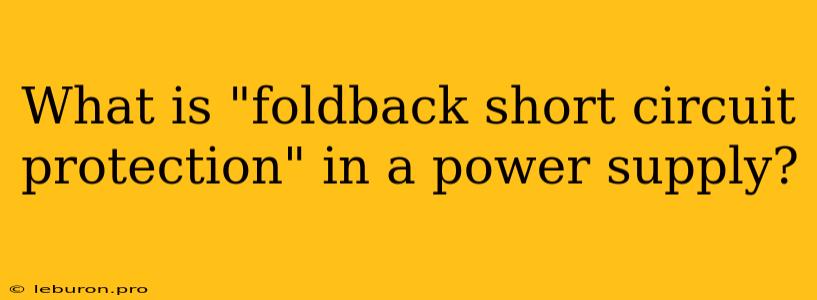What is "Foldback Short Circuit Protection" in a Power Supply?
Power supplies are an essential component in many electronic devices, delivering the necessary voltage and current to operate circuits and components. A critical aspect of power supply design is ensuring safe operation, particularly under fault conditions like short circuits. One common method used to protect power supplies from short circuits is foldback short circuit protection. This article delves into the workings of foldback short circuit protection, its benefits, and how it differs from other short circuit protection methods.
Understanding Short Circuit Protection
A short circuit occurs when an unintended low-resistance path forms between the output terminals of a power supply. This can happen due to faulty components, accidental contact, or other unforeseen events. Without protection, a short circuit can lead to:
- Excessive current flow: The power supply attempts to deliver a massive current to the short circuit, potentially exceeding its safe operating limits.
- Overheating and damage: The excessive current can cause components within the power supply, like transistors and fuses, to overheat and fail.
- Fire hazard: Overheated components can ignite, posing a fire risk.
- Damage to connected devices: The high current can damage the electronic devices connected to the power supply.
How Foldback Short Circuit Protection Works
Foldback short circuit protection is a clever method that limits the current delivered during a short circuit, while also reducing the power dissipated by the power supply. It operates by dynamically adjusting the output current and voltage in response to a short circuit. Here's how it works:
1. Initial Current Limit
When a short circuit occurs, the power supply initially reacts by limiting the output current to a pre-defined value. This initial current limit prevents immediate damage to components but allows a small amount of current to flow through the short circuit.
2. Foldback Mechanism
If the short circuit persists, the foldback mechanism kicks in. This mechanism reduces both the output current and voltage simultaneously, creating a "foldback" effect on the power supply's output characteristics.
3. Reduced Power Dissipation
The foldback mechanism is crucial because it drastically reduces the power dissipated by the power supply during the short circuit. Since power is calculated as the product of voltage and current (P = V * I), reducing both simultaneously significantly lowers the power dissipation. This helps prevent overheating and damage to the power supply.
4. Recovery
Once the short circuit is removed, the output voltage and current gradually return to their normal operating values. The rate of recovery can be adjusted depending on the specific power supply design.
Benefits of Foldback Short Circuit Protection
Foldback short circuit protection offers several advantages over other protection methods:
- Effective Short Circuit Protection: It reliably limits the current during a short circuit, preventing excessive current flow and component damage.
- Reduced Power Dissipation: The foldback mechanism reduces the power dissipated by the power supply, minimizing overheating and increasing safety.
- Improved Reliability: Foldback protection contributes to the overall reliability of the power supply by protecting it from potential damage.
- Flexibility: The foldback parameters (current limit, foldback ratio) can be adjusted during the design process to match the specific requirements of the application.
Comparing Foldback Protection with Other Methods
Current Limiting: Simple current limiting circuits abruptly cut off the output current when a short circuit occurs. While effective, this can cause a sudden interruption of power to connected devices, potentially causing issues in some applications.
Overcurrent Protection: Overcurrent protection uses fuses or circuit breakers to interrupt the current path during a short circuit. While simple and reliable, fuses and circuit breakers can be slow to react and may require replacement after a short circuit.
Foldback short circuit protection provides a superior solution by combining the current limiting and overcurrent protection advantages. It allows for a controlled current limit and ensures minimal power dissipation during the short circuit.
Applications of Foldback Short Circuit Protection
Foldback short circuit protection is widely implemented in a variety of power supply applications, including:
- Linear power supplies: These power supplies use transistors to regulate the output voltage. Foldback protection is essential in linear power supplies to prevent excessive current flow and transistor failure.
- Switching power supplies: Switching power supplies use switching transistors to regulate the output voltage. Foldback protection helps to protect these transistors from short circuits.
- Battery chargers: Foldback protection can be incorporated into battery chargers to safeguard against short circuits during the charging process.
Conclusion
Foldback short circuit protection is a valuable technique for ensuring safe and reliable operation of power supplies. By dynamically adjusting the output current and voltage, it effectively limits current during a short circuit while reducing power dissipation. This protection method is crucial for preventing damage to the power supply and connected devices, ensuring the safe and efficient operation of electronic systems.
